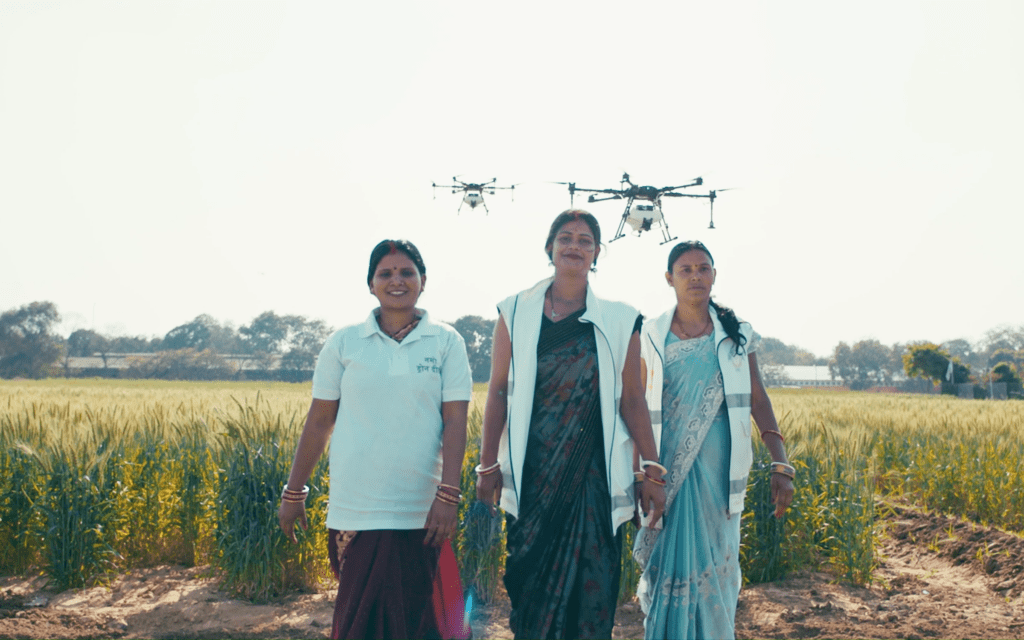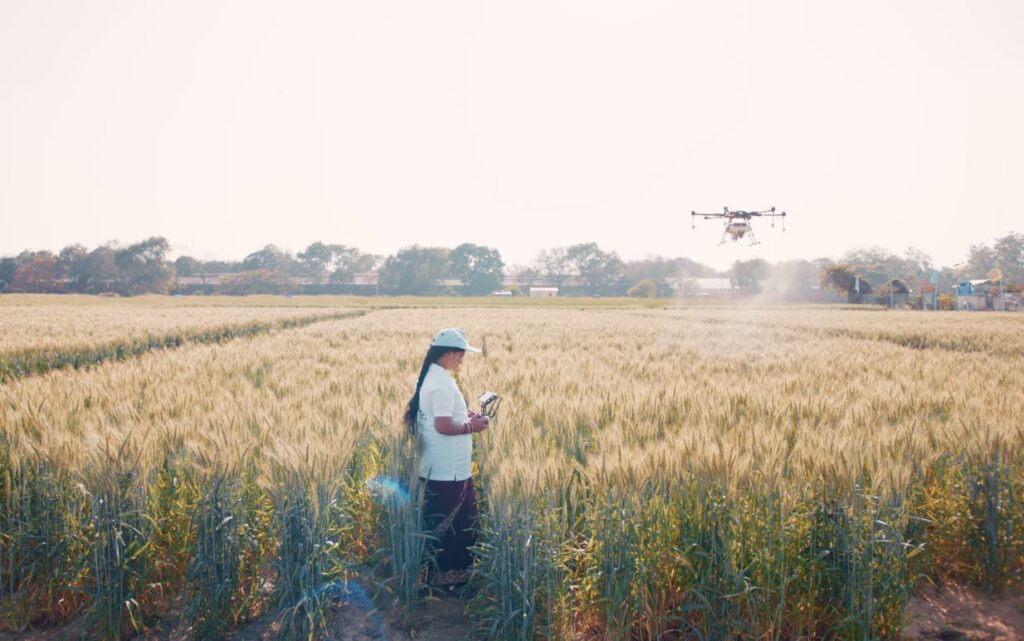by Darpan Sachdeva

When Technology Meets Empowerment
Innovation has always fascinated me. Not just for its technical brilliance, but for its potential to transform lives in ways we can’t always predict. There’s something magical about seeing technology find its way into unexpected hands and watching what unfolds.
This magic is precisely what’s happening in rural India today, where women who once never imagined leaving their villages are now piloting sophisticated drones across vast farmlands. They call themselves “Drone Didis” – “didi” being the Hindi word for sister – and they’re revolutionizing agriculture while redefining their own possibilities.
The Unexpected Pilots
When most of us picture drone operators, we might imagine tech enthusiasts in urban settings or specialized agricultural experts. Rarely do we envision women from remote Indian villages who, until recently, had limited education and economic opportunities.
Yet the Namo Drone Didi program, launched by the Indian government in 2023, is turning this expectation on its head. The initiative trains rural women to operate agricultural drones, creating a ripple effect of benefits: empowering women, modernizing farming practices, and boosting crop yields.
What strikes me most about this program is its elegant simplicity. It identifies two challenges – the need for precision agriculture and women’s economic empowerment – and addresses both with a single solution.
Technology That Transforms Fields
The technical advantages of drone-based farming are impressive. Agricultural experts about the Drone Didi program, they have highlighted several key benefits:
Precision application: Drones can distribute fertilizer with incredible accuracy, reducing waste and environmental impact
Resource efficiency: Drone spraying uses up to 90% less water than traditional methods
Labor efficiency: One Drone Didi can cover five acres in the same time it would take multiple workers to cover half an acre manually
Reduced chemical exposure: Operators remain at a safe distance while the drone applies fertilizers or pesticides
But statistics only tell part of the story. The real transformation happens person by person, village by village.
From Household to Sky: The Journey of a Drone Didi
Imagine being Sangita Devi from Bihar, whose world once extended little beyond her home and fields. Before becoming a Drone Didi, her family couldn’t afford a bicycle. Today, she owns an auto-rickshaw and has become a local celebrity.
Or consider Sumintra Devi, who married young and was expected to focus exclusively on household duties. Now her children proudly call her “Pilot Mummy” and dream of her flying airplanes someday.
Then there’s Kajol Kumari, who leveraged her experience with a self-help group to open a small agricultural supply shop. Becoming a Drone Didi complemented her entrepreneurial spirit perfectly. She’s now expanding her business and planning to send her children to better schools.
Their stories reveal something powerful about innovation: its greatest impact often comes not from the technology itself, but from how it reshapes human potential.

The Power of Self-Help Groups
What makes the Drone Didi program particularly effective is its foundation in India’s robust network of women’s self-help groups (SHGs). Unlike American self-help groups which focus primarily on personal development, India’s SHGs are economic and social collectives that provide mutual support, pooled savings, and access to microloans.
Organizations like JEEViKA in Bihar have been building these networks for years, creating an infrastructure of trust and cooperation among rural women. The Drone Didi program leverages this existing foundation, providing nearly 15,000 drones to SHGs across India by the end of next year.
This approach ensures that the benefits extend beyond individual pilots. Each drone becomes a community asset, with other SHG members trained as technicians who can maintain and repair the equipment. The income generated is often reinvested in community initiatives or other small businesses.
Watch: Drone Didis Taking Flight
When Innovation Lands in Unexpected Hands
What excites me most about programs like Drone Didi is how they challenge our assumptions about who can benefit from cutting-edge technology. Too often, we imagine that sophisticated innovations will primarily serve those who are already privileged – the educated, the wealthy, the urban.
But some of technology’s most transformative impacts happen when it reaches those who have been historically excluded from progress. A drone in the hands of a rural woman in Bihar represents more than just agricultural efficiency; it represents a fundamental shift in what’s possible.
This reminds me of other examples where technology found unexpected applications in developing regions:
- Mobile banking transforming financial access in Kenya
- Low-cost solar power bringing electricity to remote villages
- Telemedicine connecting isolated communities with healthcare expertise
In each case, the technology itself was important, but the real innovation was in reimagining who could use it and how.
The Ripple Effects of Empowerment
The beauty of programs like Drone Didi lies in their cascading benefits. When women earn income and gain technical skills, research consistently shows they invest in their families’ health, education, and well-being. Children – especially girls – grow up with expanded notions of what’s possible for their futures.
Communities benefit too. As these women gain economic influence, they often secure greater voices in local decision-making. The skills they acquire transfer to other domains, creating a more adaptable workforce ready for future innovations.
And there are environmental benefits as well. Precision agriculture reduces chemical use, conserves water and ultimately leads to more sustainable farming practices – critical considerations in a world facing climate change and resource constraints.
Looking to the Horizon
The Drone Didi program is still in its early stages, but its potential trajectory is inspiring. As drone technology continues to evolve, these women could expand into crop monitoring, gathering data on soil conditions, identifying pest outbreaks early, or creating detailed maps of agricultural land.
Some might become trainers themselves, teaching the next generation of Drone Didis. Others might leverage their technical skills to branch into different technological domains. And a few might even develop innovations of their own – adaptations or applications we haven’t yet imagined.
As Kajol, one of the women says “This is just the beginning. Wait and see what’s coming.”
The Lessons for All of Us
There’s a profound lesson here for anyone interested in technology and development. The most powerful innovations aren’t always the most complex or advanced – they’re the ones that find their way to people who can use them to transform their circumstances.
This requires us to think differently about how we design and deploy technology. It means engaging with communities not just as recipients of innovation but as active participants in shaping how technology is used.
And it means recognizing that sometimes, the most revolutionary application of a technology isn’t the one we originally envisioned. When drones were first developed, few would have predicted they would become tools of empowerment for women in rural India.
Yet here we are, watching Drone Didis take flight – both literally and figuratively – proving once again that when innovation meets opportunity, the sky is truly the limit.
What innovative technologies have you seen making unexpected positive impacts in communities?
Share your thoughts in the comments below.
 Darpan Sachdeva is the CEO and Founder of Nobelthoughts.com. Driven by a profound dedication to Entrepreneurship, Self-development, and Success over an extended period, Darpan initiated his website with the aim of enlightening and motivating individuals globally who share similar aspirations. His mission is to encourage like-minded individuals to consistently pursue success, irrespective of their circumstances, perpetually moving forward, maintaining resilience, and extracting valuable lessons from every challenge.
Darpan Sachdeva is the CEO and Founder of Nobelthoughts.com. Driven by a profound dedication to Entrepreneurship, Self-development, and Success over an extended period, Darpan initiated his website with the aim of enlightening and motivating individuals globally who share similar aspirations. His mission is to encourage like-minded individuals to consistently pursue success, irrespective of their circumstances, perpetually moving forward, maintaining resilience, and extracting valuable lessons from every challenge.


